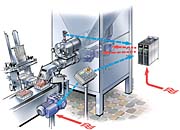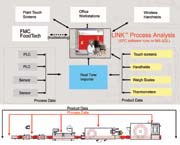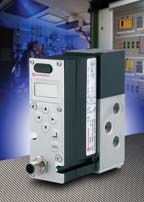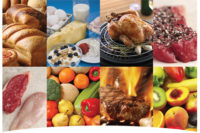
A couple decades ago, many manufacturing plants-especially in the automotive industry-complained that automation cells couldn't "talk" to one another. Each cell was efficient in what it did, but there was no way to communicate its internal data to the shop floor or to management. In response, GM launched a concerted first effort using manufacturing automation protocol (MAP) networks to connect "islands of automation" and resolve the plant-to-enterprise communications gap.
According to Darren Elliott, chief electrical engineer at RA Jones, machine controls in the food industry have crossed most application hurdles. Adequate control capabilities are easy to build into any machine using just about any automation platform. However, Brent Wallen, account manager, food/beverage at CCS Inc., still sees more of the islands of automation approach among machine builders, especially for the meat and poultry industry. He notes that if you mix brands of fryers, ovens and chill cells, there will still be proprietary architectures that can't talk to each other.
New mantra-smaller, connected
The concept of smaller footprints is never out of style whether it's related to the amount of floor space a machine occupies or whether it's the human machine interfaces (HMIs), which have become smaller thanks to reliable flat-panel displays. One way to decrease the amount of floor space a machine uses is to combine the functions of electronics, reducing the number of boxes required to house it. According to Dan Throne, food and packaging industry manager for Bosch Rexroth Automation, combining a full PLC, multiaxis motion controller and a servo drive in the same box not only reduces space requirements on the machine, but also can easily cut the cost from $6,000 to $10,000 for separate boxes, to about a $1,000 for a multifunction box. Throne says that one servo drive, for example, might run as many as seven drives plus another servo drive, making a system more practical for OEMs who build case packers, collating devices and stacking devices, which typically run with just pneumatic cylinders.
Reducing panel size also helps reduce the size of machines, and there are new ways to accomplish this. According to Helge Jensen, global business area manager for food & beverage, Danfoss Drives, "Today, panel size is reduced as there is no need for AC reactors on the line side of VFDs (variable frequency drives) if a DC choke is included inside the VFD. Also, side-by-side VFD mounting means smaller enclosures." Danfoss' next generation of VFDs has increased temperature ratings to 50°C, requiring smaller panels and less air conditioning.
RA Jones ships machines-often custom-all around the world. For Jones, smaller, smarter and simpler means consolidating most of the controls into a black box. According to Elliott, "We used to have a PLC, dedicated motion controller and a PLS (programmable limit switch)-and they were standalone units." For OEMs, he says, much of the complexity involved in handshaking between these systems has gone away because the systems are co-located in the same device, and the technology provider handles handshaking behind the scenes. Utilizing new HMI technology can help reduce machine size and improve reliability. "Our new standard controls product has been developed on the Siemens MP 270 platform," says Thomas Lundqvist, LINK product line manager, FMC FoodTech. "The system runs on top of Windows CE and uses a flashcard memory instead of a hard drive with moving parts. This is why the system can deliver a fairly advanced, but still robust, easy-to-maintain and cost-effective solution, offering functionality not far from what PC-based control systems can offer."
Size may be important, but making HMIs simple to use has taken on new meaning. "Give me more graphics, don't give me words," says Mike Wagner, Rockwell's chief business development manager for OEM programs. "Why isn't a packaging machine as easy to run as a copy machine?" Wagner believes that early on the problem with HMI screen complexity was caused by machine builders not being in tune with what customers wanted. The control engineers, too, were isolated from the end user/buyer, and didn't understand the plant floor. That's all changed now, he says. Rockwell Automation insists on meetings before every large scale project where every level-customer and machine builder-is represented. Key criteria, such as functional specifications, definition of operation, machine and graphical interfaces and multi-language switching are covered. "The assumption is that the machine will run at rate," says Wagner. "The questions now are: how easy is it to plug and play on the plant floor, and can an operator with a basic education set up, maintain and operate the machine?"
Networking
According to Bill Black, controllers product manager, GE Fanuc Automation, "Ethernet everywhere is becoming a big standard all the way from HMI to microcontroller." It allows producers to get information easily and quickly all the way to the plant level network. Black suggests producers become Ethernet ready by procuring systems that allow them to receive and send data from the plant floor to their plant-wide network regardless of how small the facility and application. While some manufacturers may not need all the data today, they will need it in the future to reduce costs and improve productivity. Most important, according to Black, is that producers adopt Ethernet instead of a proprietary network because proprietary networks may not be supported into the future.

But it takes more than just a language to communicate, and this is where protocols come into play. According to Throne, Open Modular Architecture Controls (OMAC) Users Group was set up to provide an appropriate platform for packaging machinery automation standardization. Now part of the ISA, OMAC provides a set of protocols that will allow users to purchase machines from anywhere-Denmark, Germany, and Texas-and set them up in a line. The machines will all talk the same tag names and the same states of operation. With help from the ISA, OMAC-based machines will tie into ISA S-88 batch systems, and this integration will bring together processing and discrete manufacturing-all under a common set of guidelines.
Currently, the OMAC Packaging Workgroup (OPW) has been subdivided into five committees to make the OMAC effort more effective. They include PackAdvantage, PackConnect, PackLearn, PackSoft, and PackML. PackAdvantage's mission statement is to identify and communicate to the packaging industry the benefits/results of using servo motion technology for packaging automation systems. PackConnect defines the control architecture platforms and connectivity requirements for packaging systems-including connection to ERP systems. PackLearn defines the educational/training needs for machine builders, user engineering/support, and technology providers. PackSoft's mission is to develop programming language guidelines for packaging machinery that will ease learning, support transportability of software across control platforms, and allow for continuing innovation by all parties. Finally, PackML has been working to define standard terminology that functions as the foundation for the common language upon which open communications can be achieved. To date, four guidelines and naming conventions have been released, which include the PackML State Model, PackML Machine Operating Modes, PackML Line Type Definitions, and PackML Pack Tags.
According to Schneider's Owens, a group to watch is the Make2Pack group, whose purpose is to harmonize OMAC PackML guidelines with ISA S-88.00.01 and .02, and the upcoming S-95 Part 3 standards. The Make2Pack group-represented by the World Batch Forum, OMAC OPW and the ISA SP-88-will develop conceptual models and a terminology for industrial automation that can be consistently applied to the total manufacturing process. This includes making/converting and packaging. The results will enable food producers to reduce overall costs and enhance responsiveness to changing business requirements.

Communicate vital information
Why all the fuss about getting these standards in place and purchasing equipment that meets the standards? Wagner points out that in most plants the maintenance people from the processing facility don't "speak" packaging, and vice versa. Therefore, it's important to have packaging and processing systems speak to each other through industry-accepted protocols, which enable recipe management and automatic setup of packaging routines. In addition, this data also communicates with ERP systems such as SAP."Associating accurate and real time information from the actual processes to customer orders, order fulfillment rates or other key performance indicators allows food manufacturers to determine correct product mix and reduce time-to-market or time-to-volume for new products-all while maintaining brand integrity and profitability," says Claus Abildgren, Wonderware's product marketing manager, production management.
Start out simple
There are benefits to acquiring data no matter how or when you start. "One of the trends we're seeing has to do with the concept of machine control and real-time statistical feedback," says David Norwood, president, Virtuant Inc. This is really new to many food manufacturers, and for those who have begun using it, they're just beginning to realize all the benefits this technology can bring. Large companies like Kraft have been using SPC techniques for some time to improve product quality.

Machine builders and system integrators can add value to SCADA software by building their own modules on top of an existing SCADA system. BakeMark (Manchester, UK), a provider of bakery ingredients, commissioned Advanced Technical Software (ATS) to install a new automation machine and monitoring system using Mitsubishi PLCs and CitectSCADA software, which was chosen for its built-in redundancy and the ability to modify it as needed. While other SCADA packages offer some form of product batching and control, the requirements of the plant precluded their use. The system covers all materials handling, storage, weighing, batching, blending, and tracing of more than 2,000 ingredients. ATS custom built two applications, Plant Manager and Line Manager, which sit on top of the Citect system and perform production scheduling and manage production line equipment. According to ATS Project Manager Geoffrey Graves, the distributed software architecture lets ATS divide the plant into two distinct areas, providing BakeMark with an increase in ingredient output of more than 50%.

Are upgrades worth it?
Any food processing machine consists of several parts: actuators and motion equipment, sensors, I/O, controller, HMI and pneumatic/hydraulic lines-to name a few. When asked whether customers should upgrade existing machine controls, industry representatives had mixed opinions on the issue. But there is agreement that while putting new controls on a machine may not increase functionality or throughput, they can, says Elliott, provide better data integration, and can send the data upstream to plant and corporate systems. According to GE's Black, it's cheaper to replace older controllers, because they just can't deliver vital process information like today's controllers. Elliott says that food producers often think of how fast they can make a product, but machine data coupled with order and production data might actually be used to slow or cut production on a line, especially when a product's sales slow. Why overproduce what can't be sold?
Retrofitting can be a complicated question. Food producers may need to look beyond retrofitting a single machine and look at refitting the line. They need to find bottlenecks and then cost justify the retrofit. "To be competitive food producers have to look at updating their control architectures and platforms. Since this is the day of information-enabled technologies, producers have to be aware of what will give them expansion capabilities later," says Wagner. He warns against updating equipment that can't be integrated into the standards-based systems that are now appearing.
Lundqvist doesn't recommend upgrading older equipment with newer controls unless parts are becoming obsolete or there is a significant payback. He suggests that adding SPC or process analysis software may be a better and more cost-effective option. When customers opt for new lines, they need to consider software that can deliver recipe management functionality, provide process data collection, and allow system redundancy.
For more information:
Darren Elliott, RA Jones,
859-991-0618,
elliott.d@rajones.com
Brent Wallen, CCS Inc.,
800-277-3077,
www.industrialcomputer.com
Dan Throne, Bosch Rexroth Automation,
847-645-3600,
dan.throne@boschrexroth-us.com
Helge Jensen, Danfoss Drives,
hjensen@danfoss.com
Thomas Lundqvist, FMC FoodTech,
+46 42 490 4030,
thomas.lundqvist@intl.fmcti.com
Mike Wagner, Rockwell,
414-382-2000,
www.rockwellautomation.com/food
Brian Owens, Schneider Electric,
800-392-8781,
www.us.schneider-electric.com
Bill Black, GE Fanuc Automation,
800-433-2682,
bill.black@gefanuc.com
Claus Abildgren, Wonderware,
949-727-3200,
www.wonderware.com
David Norwood, Virtuant Inc.
770-977-7309,
www.virtuant.com



